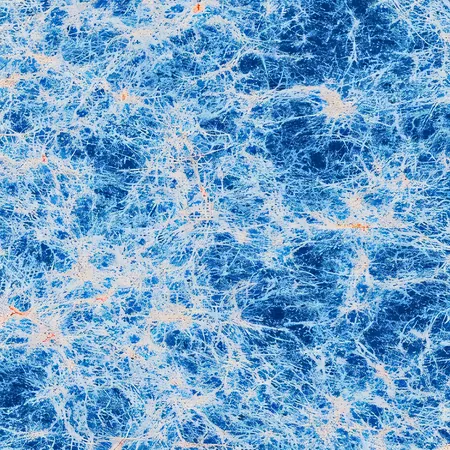
Astronomers Unveil First Direct Image of the Cosmic Web That Connects the Universe
2025-06-30
Author: Ying
Prepare to be amazed: space isn’t the empty void we once thought! It’s intricately woven with strands of matter so elusive that even the most advanced telescopes struggle to capture them. This vast network, known as the cosmic web, acts as the hidden backbone of our universe, anchoring galaxies and guiding their development.
Breaking New Ground in Cosmic Exploration
Until recently, the delicate filaments that weave this web existed only in simulations and theoretical models. But now, astronomers have made a groundbreaking discovery that brings one of these filaments into full view.
This astonishing observation comes from a distant patch of sky where two ancient quasars blaze fiercely over 11 billion light-years away, illuminating a faint bridge of hydrogen that connects them.
A Team Effort to Illuminate the Cosmos
An international coalition, headed by the University of Milano-Bicocca and in collaboration with the Max Planck Institute for Astrophysics, centered their sights on these quasars. Each quasar hosts a voracious black hole and exists from an era when the universe was just 2 billion years old.
The scientists meticulously tracked this slender filament of gas, measuring it across a staggering distance of approximately 3 million light-years using the cutting-edge Multi-Unit Spectroscopic Explorer (MUSE) attached to the European Southern Observatory's Very Large Telescope (VLT) in Chile.
Unlocking the Secrets of Cosmic Gas Flow
Thanks to MUSE's capability to analyze every pixel in its field of view, astronomers could separate the filament's faint hydrogen signals from the noisy cosmic background. This discovery provides a crucial glimpse into the early universe.
The image captures the gas flowing along a gravitational highway toward the edges of these galaxies, an area known as the circumgalactic medium. This flow is vital, serving as the raw ingredient for future star formation.
Validation of Theories About Dark Matter
This remarkable observation not only confirms key predictions of cold dark matter theories but also reveals that galaxies develop by siphoning gas through these web-like funnels instead of just consuming isolated clouds. Interestingly, cold dark matter is believed to constitute about 85% of the universe’s mass—most of which remains invisible to conventional telescopes.
Fascinating Insights from MUSE
"By capturing the faint light emitted by this filament—traveling for almost 12 billion years—we were able to accurately depict its structure," shares Davide Tornotti, a Ph.D. student at the University of Milano-Bicocca and lead on this study.
For the first time, researchers could directly measure the border between gas present in galaxies and that within the cosmic web. This study has extensively utilized MUSE, accumulating over 100 hours of observation.
Bringing Simulations to Life
Simulations at the Max Planck Institute modeled gravity as the architect that draws dark matter into an endless framework. This ordinary gas then settles into this structure, much like morning fog in a valley.
When the researchers compared this synthetic model with their observations, the results were strikingly congruent. The fine details in the observed glow matched perfectly with predicted knots, suggesting that simulations accurately capture cosmic structures.
How Cosmic Filaments Nourish Galaxies
This gas flow along the filaments doesn’t just help in star formation; it shapes the very appearance of galaxies. Fresh hydrogen fed into their disks fuels spiral arms, bursts of radiation, and chemical enrichment.
Without a steady inflow of gas, galaxies would quickly deplete their resources and fade away. The newly captured filament demonstrates that this inflow occurs early and on a grand scale, offering a clearer boundary between intergalactic gas and the more concentrated material bound to galaxies.
Looking Ahead: Mapping the Cosmic Web
"We are thrilled by this direct, high-definition observation of a cosmic filament. However, as they say in Bavaria: 'One doesn’t count,'" concludes Fabrizio Arrigoni Battaia, a staff scientist at MPA.
The researchers are eager to gather more data to unveil additional structures, with the goal of creating a comprehensive map of gas distribution and flow in the cosmic web.
Future studies powered by next-generation instruments, like the planned high-resolution spectrographs for the Extremely Large Telescope, will aim to discover more cosmic filaments.
With each newly uncovered thread, we tighten our understanding of dark matter physics and galaxy evolution. For now, the stunning image linking the two distant quasars stands as the clearest portrayal yet of the web that connects our universe. It provides a mesmerizing look at gas streaming along a cosmic highway, nurturing galaxies from their very beginnings.
This remarkable achievement confirms that dedication and advanced observation can illuminate structures once thought to be out of reach. As astronomers accumulate more data, an even clearer picture of our universe's hidden framework will slowly emerge—one faint glow at a time.



 Brasil (PT)
Brasil (PT)
 Canada (EN)
Canada (EN)
 Chile (ES)
Chile (ES)
 Česko (CS)
Česko (CS)
 대한민국 (KO)
대한민국 (KO)
 España (ES)
España (ES)
 France (FR)
France (FR)
 Hong Kong (EN)
Hong Kong (EN)
 Italia (IT)
Italia (IT)
 日本 (JA)
日本 (JA)
 Magyarország (HU)
Magyarország (HU)
 Norge (NO)
Norge (NO)
 Polska (PL)
Polska (PL)
 Schweiz (DE)
Schweiz (DE)
 Singapore (EN)
Singapore (EN)
 Sverige (SV)
Sverige (SV)
 Suomi (FI)
Suomi (FI)
 Türkiye (TR)
Türkiye (TR)
 الإمارات العربية المتحدة (AR)
الإمارات العربية المتحدة (AR)